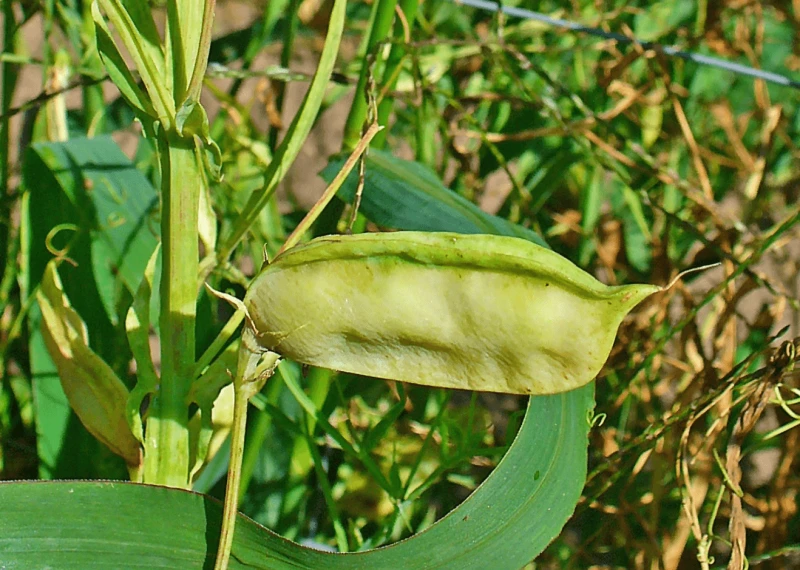This hardy pea plant is climate-change resistant, but sometimes poisonous. Here’s how gene editing could turn it into a ‘climate crisis’ crop
This hardy pea plant is climate-change resistant, but sometimes poisonous. Here’s how gene editing could turn it into a ‘climate crisis’ crop


It is grown in some of the world’s most inhospitable, arid regions and is noted for being rich in protein. But the grass pea – although hardy and nutritious – comes with a catch. It contains a poison that can occasionally trigger irreversible paralysis, particularly among individuals who are already undernourished.
Nevertheless, poisoning from Lathyrus sativus still occurs in Bangladesh, India, Pakistan, Nepal, Ethiopia and Algeria.
But now a group of UK scientists studying the grass pea have revealed the secrets of its poison production. In the near future they expect to create versions that are free of its toxic side-effects.
“Very soon, we will be able to make safe versions of the grass pea and provide our undernourished, overheated planet with a very valuable crop,” said project scientist Dr Anne Edwards, of the John Innes Centre in Norfolk.
The key biochemical steps by which the grass pea’s poison is made were revealed when scientists decoded the highly complex genome of Lathyrus sativus. They discovered details of the pathways that lead to the pea poison’s manufacture, leaving them poised to use gene-editing or standard breeding techniques to create versions that are poison-free or extremely low in toxins.
This is an excerpt. Read the original post here

 | Videos | More... |

Video: Nuclear energy will destroy us? Global warming is an existential threat? Chemicals are massacring bees? Donate to the Green Industrial Complex!
 | Bees & Pollinators | More... |

GLP podcast: Science journalism is a mess. Here’s how to fix it

Mosquito massacre: Can we safely tackle malaria with a CRISPR gene drive?

Are we facing an ‘Insect Apocalypse’ caused by ‘intensive, industrial’ farming and agricultural chemicals? The media say yes; Science says ‘no’
 | Infographics | More... |

Infographic: Global regulatory and health research agencies on whether glyphosate causes cancer
 | GMO FAQs | More... |

Why is there controversy over GMO foods but not GMO drugs?

How are GMOs labeled around the world?

How does genetic engineering differ from conventional breeding?
 | GLP Profiles | More... |

Alex Jones: Right-wing conspiracy theorist stokes fear of GMOs, pesticides to sell ‘health supplements’




 Viewpoint — Fact checking MAHA mythmakers: How wellness influencers and RFK, Jr. undermine American science and health
Viewpoint — Fact checking MAHA mythmakers: How wellness influencers and RFK, Jr. undermine American science and health Viewpoint: Video — Big Solar is gobbling up productive agricultural land and hurting farmers yet providing little energy or sustainabilty gains
Viewpoint: Video — Big Solar is gobbling up productive agricultural land and hurting farmers yet providing little energy or sustainabilty gains Fighting deforestation with CO2: Biotechnology breakthrough creates sustainable palm oil alternative for cosmetics
Fighting deforestation with CO2: Biotechnology breakthrough creates sustainable palm oil alternative for cosmetics Trust issues: What happens when therapists use ChatGPT?
Trust issues: What happens when therapists use ChatGPT? California, Washington, Oregon forge immunization alliance to safeguard vaccine access against federal undermining
California, Washington, Oregon forge immunization alliance to safeguard vaccine access against federal undermining 30-year-old tomato line shows genetic resistance to devastating virus
30-year-old tomato line shows genetic resistance to devastating virus The free-range chicken dilemma: Better for birds, but with substantial costs
The free-range chicken dilemma: Better for birds, but with substantial costs ‘You have to treat the brain first’: Rethinking chronic pain with Sanjay Gupta
‘You have to treat the brain first’: Rethinking chronic pain with Sanjay Gupta
